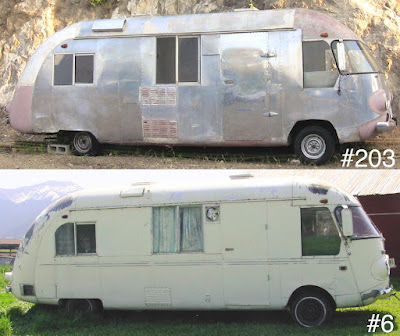 |
| January 1979, Frontier Town, El Cajon CA |
Chevrolet made rapid and extensive upgrades to the Corvair platform between 1960 and 1965, and Dave Peterson eagerly incorporated these developments into his UltraVans.
For example, starting with the original engines of 1960 (140 cubic inch displacement), Chevrolet increased cylinder/piston diameter in 1961 (to 144.7 c.i.d.), and piston/crankshaft stroke in 1964 (to 163.7 c.i.d.). The initial 80 hp engines evolved into a dozen different configurations, and in particular the 102 hp (1962), 110 hp (1964), and 140 hp (1965) engines found their way into UltraVans as soon as they became available.
Improvements to the Corvair rear suspension were likewise quickly adopted into the vans. The initial "swing arm" configuration had been a simple, robust, and relatively inexpensive arrangement, commonly used in many small rear engine vehicles (Corvair, Volkswagen, Renault) - but it had drawbacks. And although the addition of a transverse leaf spring "camber compensator" in 1964 effectively nullified Ralph Nader's criticisms, Chevrolet wasn't resting on its laurels.
For 1965, Chevrolet introduced a sophisticated new rear suspension featuring trailing link control arms stabilized by lower strut rods and by the driveshafts themselves. Peterson found that the new arrangement allowed him to move the drive wheels outboard for the coaches by simply relocating the control arms and lengthening the driveshafts and strut rods - thereby eliminating the need for the ornamental dually wheels.
According to Christy Barden's 1992 newsletter article "The First 24 UltraVans", Peterson told him that coach #11/109 (we don't know what this refers to, possibly one of the Travalons being used as a testbed) received a "leading arm (links) suspension later upgraded to trailing arm," and that #204 received a "modified late model suspension." But since neither of these coaches has been identified in the last 40 years it is hard to say how closely they resemble the arrangement installed on #205, #206, #209, #20, and #211. For these coaches, Peterson decided to install Chevrolet's new suspension backwards - creating a "leading arm" suspension. Nobody knows why.

UltraVan #205 is a fairly typical example of the early 2nd generation UltraVan. The turn signals are installed between the Econoline headlights and the surface mounted bumpers, the rear windows are squared off, there is no tow hitch. The wedding cake taillights are still mounted in the lower position, but the galley has now been rearranged with the stove on the right. An engine cooling air vent has been installed on the right side, and a large rectangular hatch installed underneath the windshield (possibly a generator compartment to support the roof air conditioner), but we don't know if these are original equipment or owner modifications.
Up front, the UltraVan emblem is long gone, replaced by a club-sponsored "UltraCoach" emblem - the legacy of a time when a club dominated by older and mostly retired couples wanted desperately to disassociate themselves from the "let it all hang out" custom vanning craze of the 1970s.
UltraVan #205 was initially delivered in 1965 to J. A. Wales Jr. of Wolfeboro NH, who paid over $9,200 for the coach. He didn't have it long though, advertising it for sale at $6,995 in the May 1966 Family Motor Coaching magazine. By May of 1967 the coach had 14,000 miles on it and the second owner Larry Selig of Albany NY was advertising it for sale in the same magazine (he wanted something bigger). Richard E. Warman of Danvers MA is the next owner listed in the customer records, followed by Mort Bryant of Atlanta GA. Mort sold the coach to Grant and Meta Brown in December 1972, who registered the coach with the UVMCC in 1973.
The next owners were Elbert & Margaret Carpenter of Camp Pendleton CA, who registered with the club in 1976; followed by Milo & Viola Webber of San Fernando CA in 1977. Sid & Bunny Chilcott of Carlsbad CA joined the Club in April 1980, then Ernest & Rose Perlich of Tarzana CA in August 1981, then Paul & Rose Schoenfeld of Marathon FL in July 1983. Finally, a CHP officer named Gary Ligget (or Legget) sold the coach to Gary S. Stern of Topanga CA, who joined the Club in February 1987. Gary has owned the coach ever since - making him by far the longest owner of record for the coach.

Gary is a musician and music producer who (among his other
credits) once ran
The Silvery Moon Studios in West Hollywood. Gary's UltraVan currently serves as his home base and practice studio.
The coach shows up in the background at :21 and 2:46 in this Honda Z600 recovery video from 2013:
https://youtu.be/X0De7ruhTXM

















































